This post may contain affiliate links. Please read our privacy policy.
Having trouble with getting your baked goods to turn out correctly? Sometimes the solution is simpler than you think! Learn how to measure flour correctly to avoid some basic baking errors.
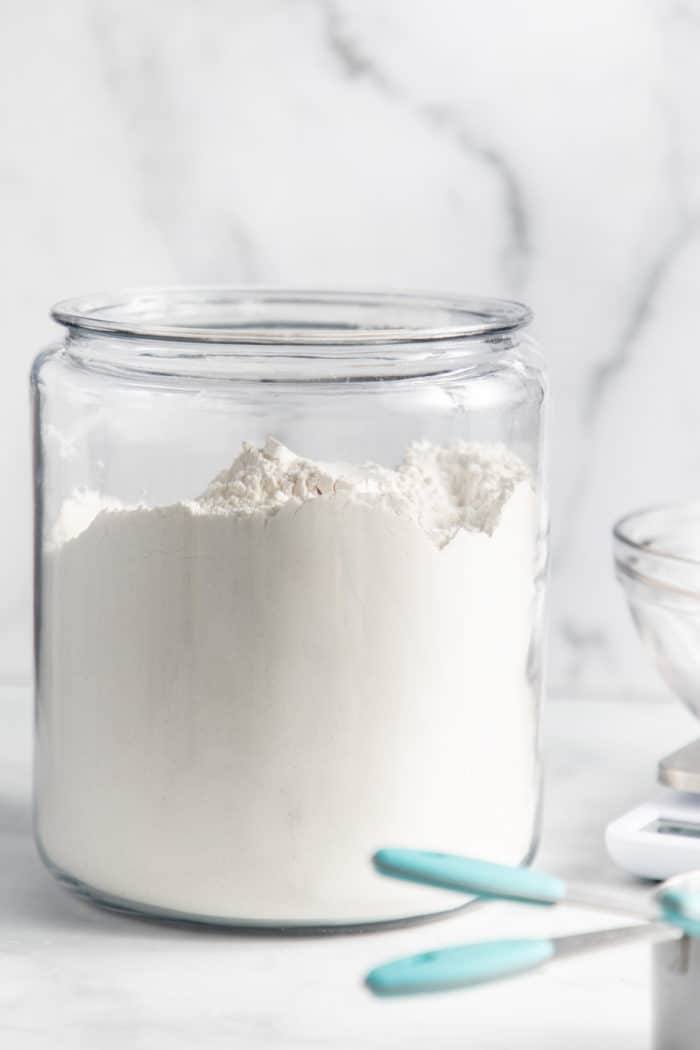
As a food blogger, I try to provide my readers with great recipes that have been tested thoroughly in my kitchen.
However, sometimes a recipe that worked well for me turns out a little less than perfect for a friend or reader.
Whenever my friends ask me why something didn’t turn out right – whether it’s my favorite chocolate chip cookies, the best chocolate cake, or homemade Bisquick, typically the first question I ask is, “How did you measure the flour?”
For years I thought dipping the measuring cup directly into the flour sack was an accurate means of measurement. However, when I started to teach myself how to bake – I realized this method can be pretty inaccurate.
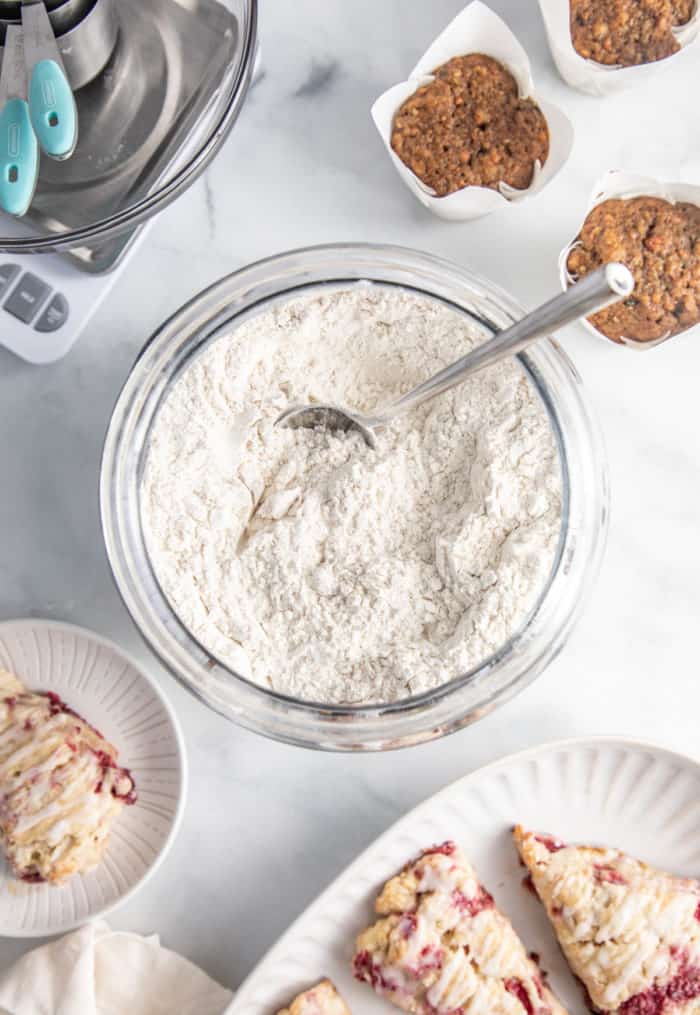
Pin this now to find it later
Pin ItWhy Your Measuring Method Matters
I decided to conduct a little kitchen experiment and measure a cup of all-purpose flour two ways.
Here were the results:
- Scooping a measuring cup into the flour and leveling: 6 oz in weight
- Spooning the flour into a measuring cup and leveling: 4.25 oz in weight
Pretty big difference, right? Especially when it comes to baking. Because just a couple extra ounces of flour can really change the texture of a baked good.
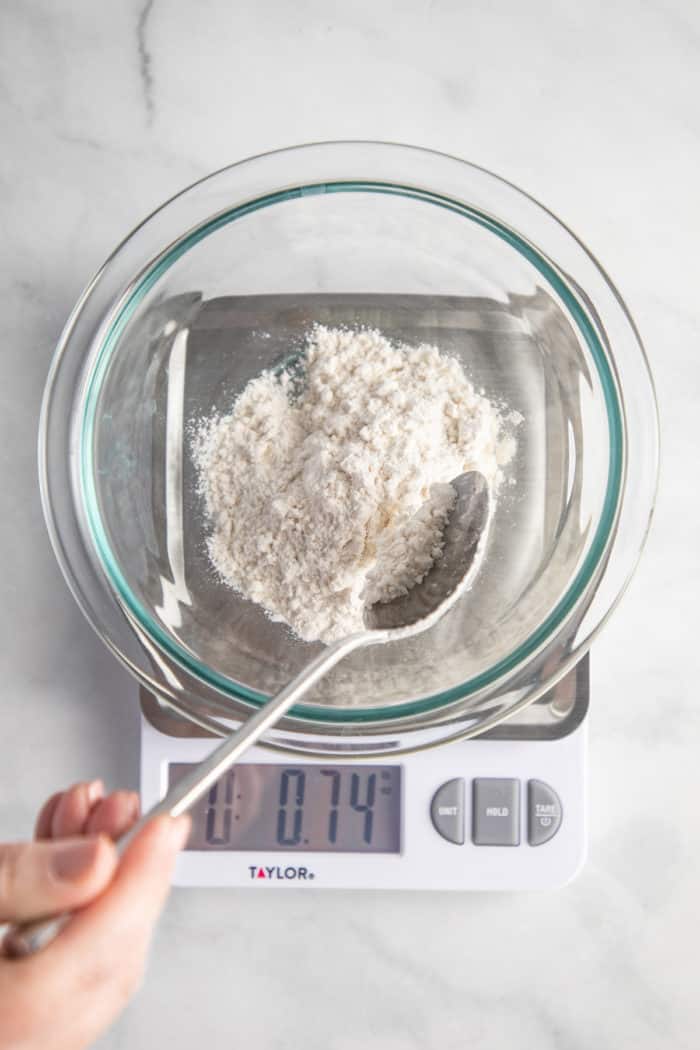
The important thing to remember is that, much like brown sugar, flour packs. Scooping the ingredient with your measuring instrument will cause packing.
Packed flour can add up quickly!
If you have a recipe with 3 cups of flour, and you scoop using your measuring cup, you could end up with 18 ounces of flour, when in reality you should have 12.75 ounces of flour.
That’s nearly an extra 3/4 cup of flour in your recipe!
That can dramatically change the results you get from a finished baked good.
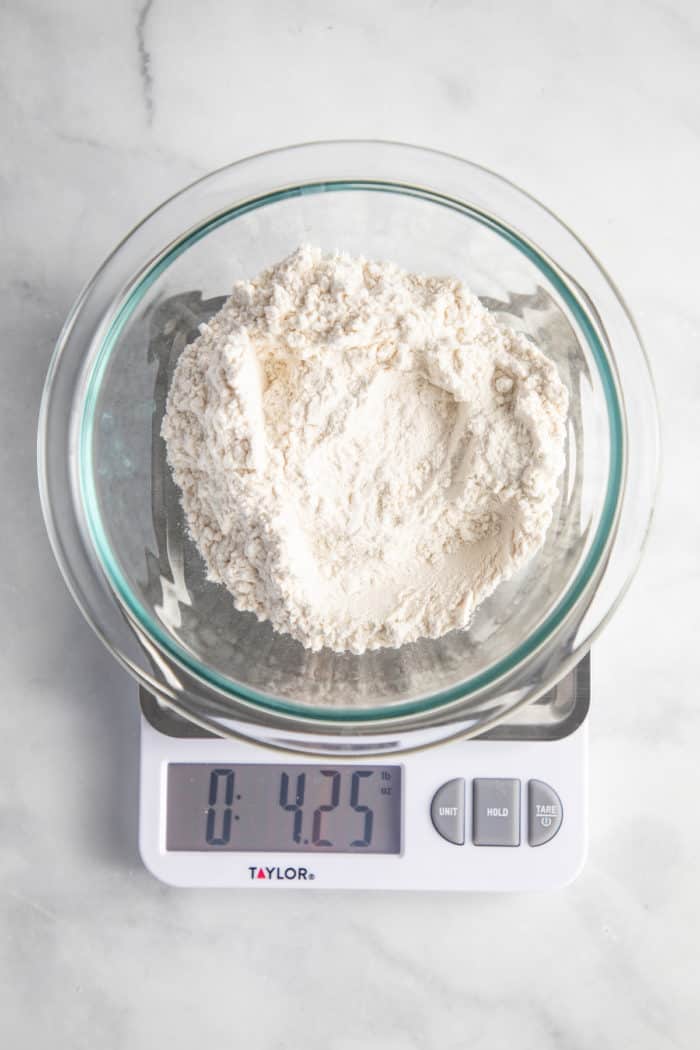
How to Measure Flour for Baking
Flour measurements can be one of the biggest variables when it comes to the finished product in baking. Weighing ingredients is by far the most accurate, but not a common practice here in the U.S.
If you’re an Alton Brown fan – like I am – you know from Good Eats that this is pretty much the only way he measures dry ingredients.
A digital scale can come in handy and is useful for more than just measuring your sugar and flour.
I use mine a lot to weigh small packages for click and ship labels via USPS, and they are also great for figuring out correct portions of meat and other items when needed.
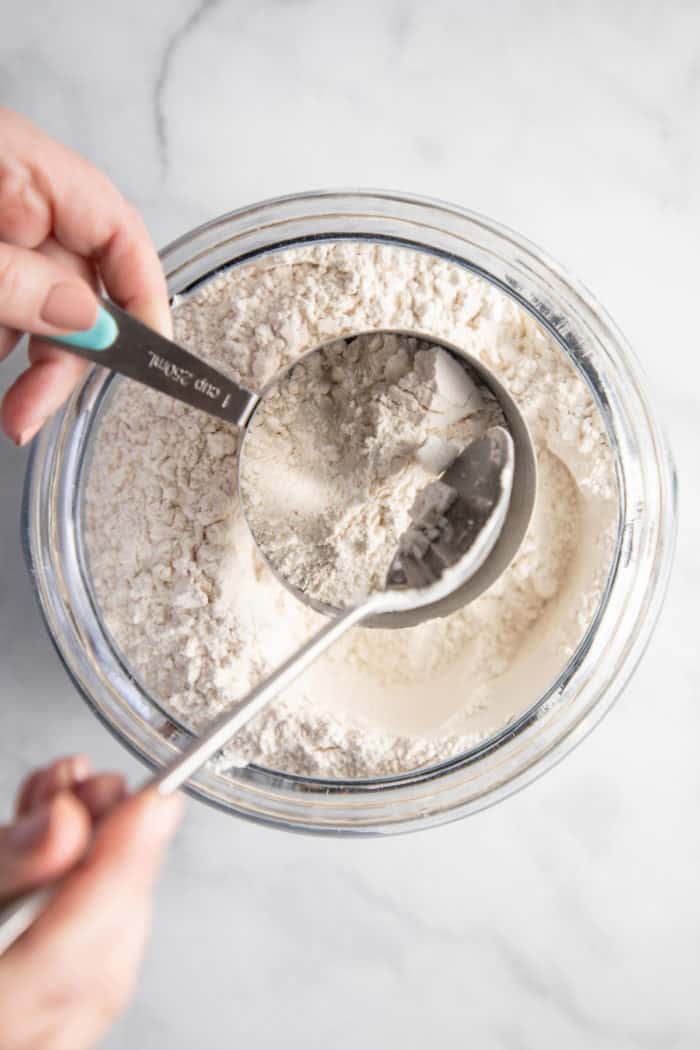
How do I Measure Flour Without a Scale?
If you don’t own a scale, when it comes to dry ingredients, you’re more than likely using a measuring cup.
Many people use measuring cups with perfect results. But remember that they can be incredibly inaccurate depending upon the method of adding the flour to the cup that you use.
What measuring cups should you use?
Although I grew up using both liquid and dry measuring cups, I’ve come to realize through blogging that a lot of people don’t own both types of cups and some don’t know that two types of measuring cups exist.
So, let’s start with the basics – if you’re going to bake, I strongly recommend picking up a set of dry measuring cups as well as at least one liquid measuring cup.
Both can be found in pretty much any store including places like Target, Amazon, the grocery store and even the dollar store.
Make sure you use the dry measuring cups for measuring flour, sugar, and other dry ingredients. Save the liquid measuring cup for milk, water, and other liquid ingredients.
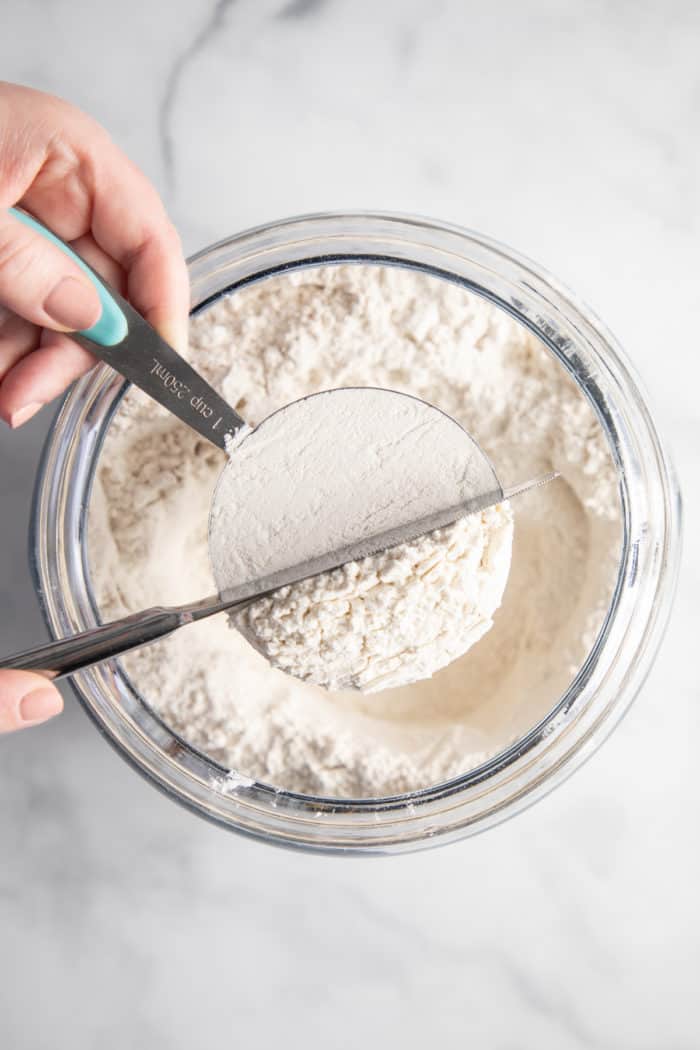
How to get an accurate flour measurement with a measuring cup
Here’s how to get a pretty accurate measurement without the use of a scale:
- Use a spoon to fluff up the flour within the container.
- Use a spoon to scoop the flour into the measuring cup.
- Use a knife or other straight edged utensil to level the flour across the measuring cup. I have a plastic straight edge that I keep in my flour bin at all times for just this purpose.
And that’s it! Now you know how to measure flour the right way so your baked goods are as perfect as possible.
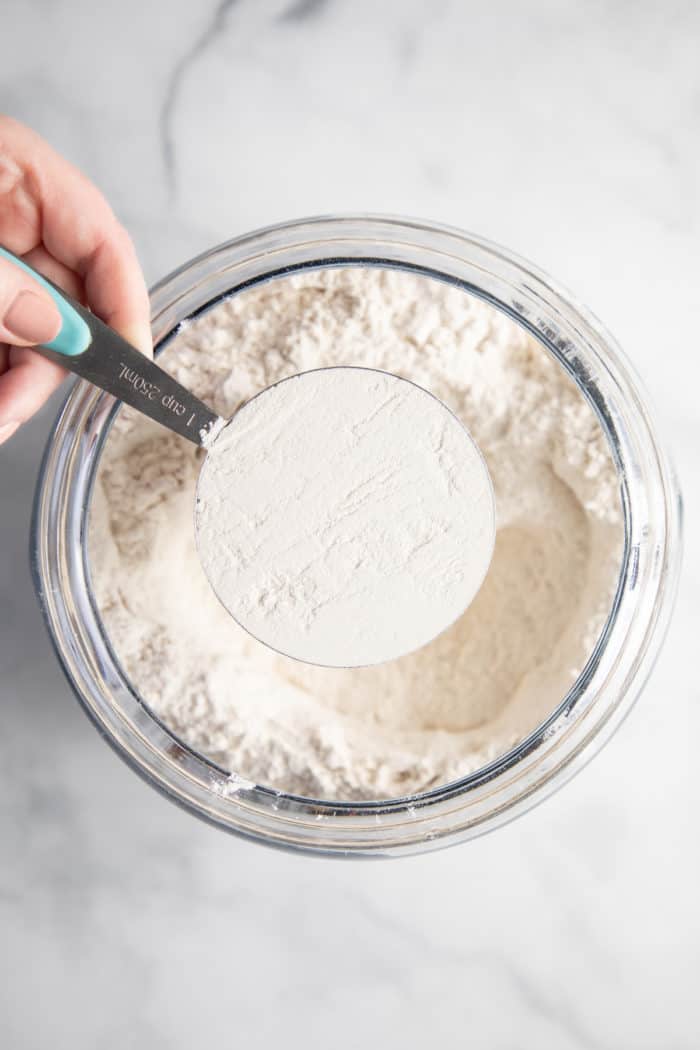
Commonly Used Weight Measurements
Here are some helpful common volumetric measurements and their weight equivalents for quick reference.
All measurements are in ounces by weight, not fluid ounces.
Flours
- all-purpose flour: 1 cup weighs 4.25 ounces
- cake flour: 1 cup weighs 4 ounces
- bread flour: 1 cup weighs 4.25 ounces
Sugars
- granulated white sugar: 1 cup weighs 7 ounces
- confectioners’ sugar (powdered sugar); unsifted: 1 cup weighs 4 ounces
- light or dark brown sugar; packed: 1 cup weighs 7.5 ounces
Butter
- butter: 1 cup weighs 8 ounces
I also definitely recommend printing out a copy of this Ingredient Weight Chart from King Arthur Flour. I laminated mine because I am kind of a messy baker. The list hangs from the side of my fridge, and I can honestly say it is one of my most used kitchen resources.
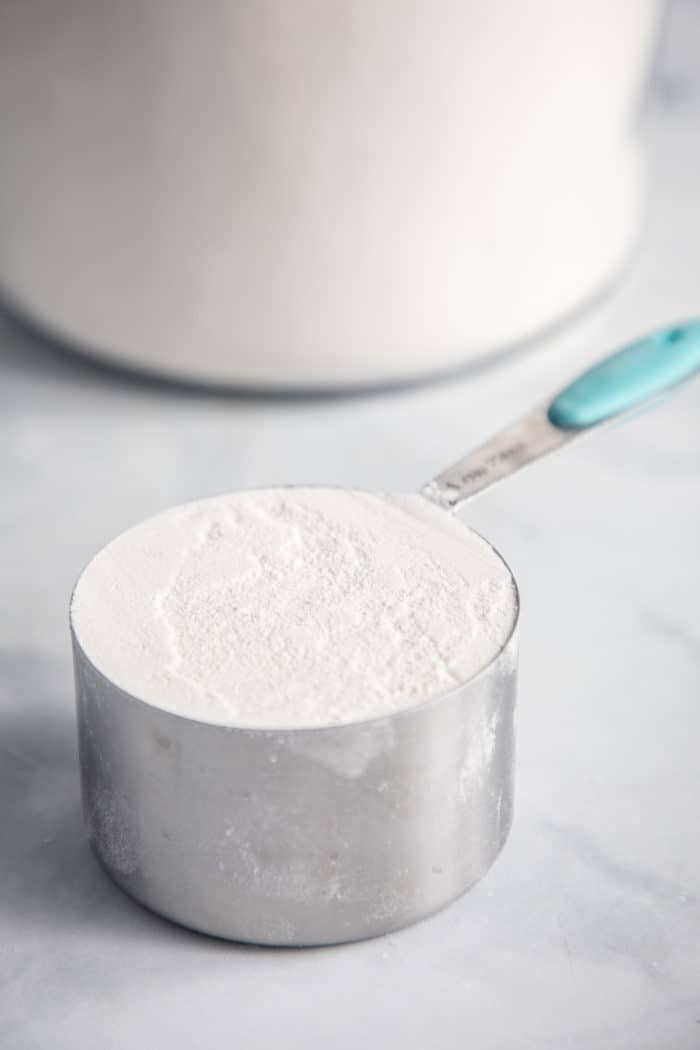
More Helpful Kitchen Tips
Whether you’re a beginner baker or a veteran in the kitchen, there are a few kitchen substitutes and tips that are helpful to keep in mind.
Whip up this simple buttermilk substitute to use in any baking recipe calling for buttermilk.
This brown sugar substitute is also a handy trick to keep in mind in case you find yourself out of brown sugar while in the middle of baking.
It’s also handy to know how to soften butter and how to soften cream cheese quickly! I always forget to set mine out, so I use these tricks all of the time.
How to Measure Flour
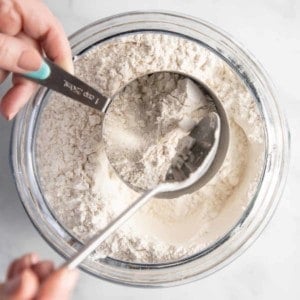
Equipment
- Spoon
- Knife or other straight-edged utensil
Ingredients
Instructions
- Use a spoon to fluff up the flour within the container.
- Use a spoon to scoop the flour into the measuring cup.
- Use a knife or other straight-edged utensil to level the flour across the measuring cup. I have a plastic straight edge that I keep in my flour bin at all times for just this purpose.
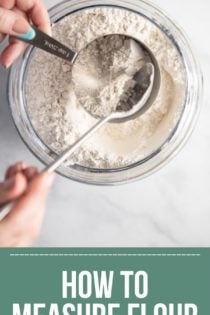
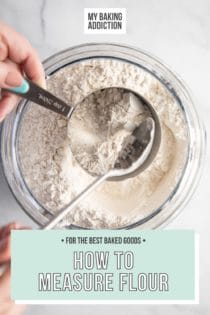
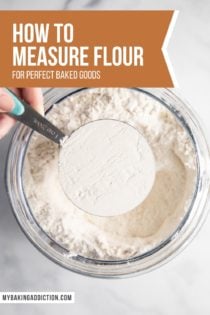
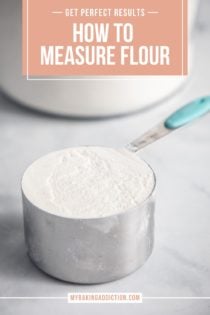
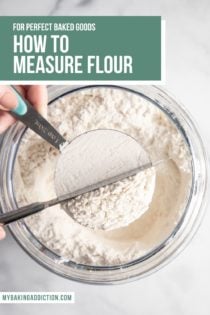









I made the “scoop measuring cup inside bag of flour” mistake when attempting to make a pound cake recently. It turned out not so great, so I’m assuming my flour technique was the cause. I won’t make the mistake again; however, not sure how I will go about storing my flour from now on. What do you store it in, so that it: a) fits nicely in the cabinet with all of the other dry goods, b) has a tight seal to keep fresh, and c) most importantly, is roomy enough to allow me to measure it correctly INSIDE/WITHIN the storage container? Would love your thoughts (and, if you know of a specific item, where I can buy it, would be fantastic!!!!) Thanks very much!! I appreciate this article you wrote and for any storage suggestions you have. :) :) Megan N
Hello! These OXO pop-top containers work great for dry goods like flour: https://www.amazon.com/OXO-Good-Grips-POP-Container/dp/B000UHYB9E/ref=sr_1_4?crid=2CKGZ1W7F1CE3&keywords=oxo+pop+top+storage+containers&qid=1562804692&s=home-garden&sprefix=oxo+pop%2Cgarden%2C151&sr=1-4
Hope this helps! Happy baking.
Jamie
I love to make homemade pizza dough but I would like to pre-measure out the flour and put it in plastic bags so I can just grab one instead of having to measure it out each time. Will this cause me any problems in how my dough rises or anything because the flour is compacted in the plastic bags for awhile?
Hi Nancy – You should be fine! Just give the flour a little “fluff” with a whisk before you use it. Hope this helps! Happy baking.
Jamie
Fluffing flour is that the reason we used a sifter. I remember putting flour in sifter while baking cookies with my mother. Never been a real baker. But this tip has made me to believe the reason my stuff never turns out as goodthe reciepe. I also seen sone pics of recipes people have cooked and it didntvlook like the pic. A matter if simple measurements makes a difference. So i will get me a scale. Thanks we’ll see if it makes a difference in my baking.
Thanks so much for stopping by, Debbie! I appreciate you taking the time to comment. Happy Baking and Good Luck!
-Jamie
The trouble with using a table knife in leveling is that those who design flatware design for looks, not for usefulness as a straightedge.
If your table knives have straight back edges, fine. But if they don’t, and you don’t have a leveler for measuring cups, I suggest going to where they sell school supplies and buying a six-inch ruler.
I’ve always just used measuring cups, but I’ve recently heard that using a scale can be better to use. It’s an added bonus that it can help you watch your waistline. Hopefully, I can find one for a decent price.
What about sifting?
Hi, Tracy! Generally, commercial flour doesn’t need to be sifted. Sifting will aerate the flour and make the batter not be so heavy, so if you’re making a cake and would like to sift the flour, you can certainly do so, but it’s really not necessary. I hope this helps!
would it be okay if I put the put the gluten in the measuring cup and see how high it would go?
I think that would be fine! Let me know how it goes!
hi there
just to share my experience. I live in the UK (but I am Italian). when I started cooking many yrs ago I decided, after reading about and experiments, that I would adopt the following 1 cup AP flour = 150 g= 5,37 oz. I got this from a seminal book on baking: English Bread and Yeast Cookery by Elizabeth David. In the course of the years I have then come across rather different formulas, the most typical being 1 cup AP = 4.25 oz. I tried few times and yet, time and time again, with the flour available here in the UK, 1 cup AP always weights 150 g with my scale.
I have come across your blog by accident and I have just given a go with your quantities…. again: what I got was 1 cup AP = 150 g!!
this is not to say that your conversion is wrong (or mine, for the matter), but just to re-inforce what you say: only a digital scale gives accurate measurements – and in baking that is very important. thanks
ciao
stefano
Thanks so much, Stefano!
Thanks so much for this. I’m so frustrated with online bread recipes. I weigh my flour for consistency and inevitably I find that the recipe writer scooped from the bag to get their measurements and then I’m hastily adding extra flour to a sodden mess. The most frustrating part is that I’m not sure that my end result is what was intended by the writer.
At least now I know that there can be a 50 gram difference per cup and make adjustments more quickly depending on what the dough looks like.
If only people would realize that weighing dry ingredients is really the best way to bake. I am APPALLED to see “bakers” on TV digging into the flour, (Food Network take a look). I am beginning to think that some of my recipes don’t come out because they are written with incorrect measuring techniques, especially nice PLUMP chocolate chip cookies recipes. After baking for 40 years, I refuse to take the blame for misdirected recipes. It’s frustrating.
Thank you for finally educating people on this really important baking technique.
Thanks so much for your feedback, Chippy! I couldn’t agree more. Have a great day.
-Jamie